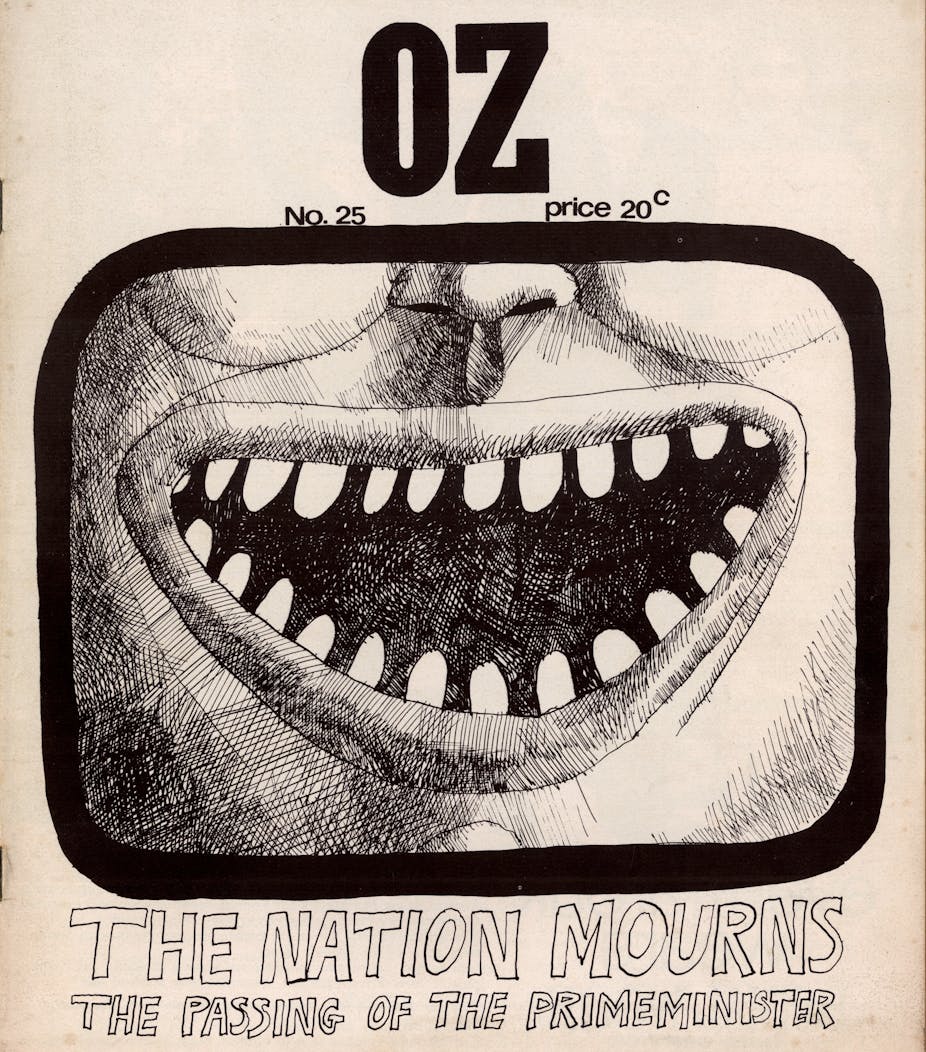Earlier this month, the University of Wollongong announced that it would house the digital archive of OZ magazine, meaning the iconic counterculture magazine will be available to a new audience – some 50 years after it first hit the streets of Sydney on April Fool’s Day 1963.
Shrouded in controversy from the outset, the magazine struck at the heart of Australia’s conservative hegemony during the 1960s. On the grounds of its content, charges of obscenity were laid against its editors Richard Neville, Richard Walsh and Martin Sharp. Neville later faced similar charges in connection with the UK edition of OZ.

Prime Minister Robert Menzies, an ineffectual ALP opposition, abortion, war, censorship, police corruption and sexual mores were some of the topics attacked and shamelessly lampooned.
The wit of the cartoons and illustrations by artists such as Sharp and Garry Shead which graced the magazine set a new standard for graphic design and enhanced the impact of the magazine, ensuring its notice by the authorities.
OZ was the first of the alternative and underground press publications to appear on the international scene – a year before the Los Angeles Free Press (1964) in the United States and later in Britain with the International Times (1966) and OZ London (1967).
Satirical and irreverent, OZ Sydney pushed the boundaries during a time of cultural and political upheaval. A new generation growing up after the second world war was attempting to reconcile the conservative culture in which they lived with a changing world in which civil rights, women’s rights, pacifism, and other challenges to existing conservative ideologies were emerging.
Tensions between the conservatism of the past and the new social movements were inevitable. Students and disaffected youth challenged the status quo, adopting a position of dissent: banned books were circulated, taboo topics such as sex and abortion were discussed openly, and establishment institutions including the church, police and politicians, were the targets of satire and protest.
Friends and pranksters
Richard Neville entered publishing in the early 1960s as features editor of Tharunka, the student newspaper at the University of New South Wales, where he was studying Arts.
He helped incite controversy through his writings and earned a reputation as a larrikin. Neville contrived elaborate pranks against the university’s Vice-Chancellor – as well as the kidnapping of Bandstand’s host Brian Henderson on live television.
Richard Neville and Richard Walsh met Martin Sharp and Garry Shead in 1962. Sharp and Shead had just produced what were to be the only two issues of the student newspaper, The Arty Wild Oat, which they published as students of the National Art School, East Sydney Technical College.

Neville informally founded OZ at his family home in Mosman in January 1963, with a group of friends including Sharp, Shead, fellow student Alex Popov, as well as editors of the University of Sydney student magazine, Honi Soit, Richard Walsh and Peter Grosse, and other Tharunka staff, Peter Kingston and Mike Glasheen. Neville took on management of OZ, throwing himself into its creation.
The first few issues of OZ were published from an office in The Rocks, Sydney - formerly horse stables - before relocating to another office in the city shortly after. The production team met each Sunday to discuss the content for the monthly issue.
How to get in strife with the censors

OZ courted controversy in both Sydney and London throughout the ten years of its lifetime 1963 to 1973.
The early charges of publishing an obscene and indecent publication occurred against OZ Sydney issues No. 1 and No. 6. The first charge was for putting a taboo topic, illegal abortion, on the cover of the magazine. The second charge was for an image of the production team pretending to urinate in the Tom Bass sculpture recently unveiled by Robert Menzies on the side of the P&O building in Sydney.
In addition, the textual content documenting social norms upset the conservative establishment. For example, in the second obscenity case, a brief satirical piece from OZ titled “The word flashed round the Arms”, was raised in the trial. Its language was dissected and its literary merits were assessed by several witnesses.

A degree of public outrage was caused by the second charge of obscenity made against OZ in 1964, which was further supported by some members of academia who opposed the stringent censorship regime in Australia at the time.
Neville, Walsh and Sharp were sentenced to custodial sentences for this offence, the presiding judge for the case wishing to make an example of them. This was later overturned after two years of appeals. The case was broadcast via the papers of the day, causing a local sensation and highlighting the opposing ideologies emerging in Australian society during the 1960s.
OZ London, launched in 1967, was steeped in psychedelic imagery, and became a paean for the ideals of the hippie movement: sex, drugs, rock ‘n’ roll, freedom of expression and expansion of the mind. The famous OZ trial of 1971 became a rallying point for this movement, with figures such as John Lennon and Mick Jagger lending their support to the magazine’s cause.
The trial inspired a book, a stage play and a large amount of media attention. The events of this period were captured by Neville in his 1995 book Hippie Hippie Shake.
Now that OZ magazine has been archived online, students of 1960s counterculture have a new opportunity to examine one of the key texts of the period.
OZ magazine is archived here.

